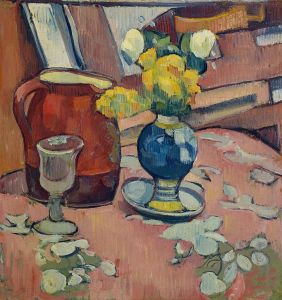
Zinnias
A hand-painted replica of Charles Demuth’s masterpiece Zinnias, meticulously crafted by professional artists to capture the true essence of the original. Each piece is created with museum-quality canvas and rare mineral pigments, carefully painted by experienced artists with delicate brushstrokes and rich, layered colors to perfectly recreate the texture of the original artwork. Unlike machine-printed reproductions, this hand-painted version brings the painting to life, infused with the artist’s emotions and skill in every stroke. Whether for personal collection or home decoration, it instantly elevates the artistic atmosphere of any space.
Charles Demuth was an American artist known for his contributions to the Precisionist movement, a style that emerged in the early 20th century characterized by its focus on sharp, geometric forms and a clear, precise representation of subjects. One of his notable works is "Zinnias," a painting that exemplifies his unique approach to still life and floral subjects.
"Zinnias" is a watercolor painting, a medium Demuth frequently employed due to its ability to convey delicate and nuanced details. The painting showcases a bouquet of zinnias, a type of flower known for its vibrant colors and varied forms. Demuth's depiction of the zinnias is both realistic and stylized, capturing the essence of the flowers while also emphasizing their structural beauty. The composition is carefully arranged, with each flower meticulously rendered to highlight its individual characteristics.
Demuth's interest in floral subjects can be traced back to his personal life and artistic influences. Born in 1883 in Lancaster, Pennsylvania, he was exposed to art from a young age and later studied at the Pennsylvania Academy of the Fine Arts. His time in Europe, particularly in Paris, exposed him to avant-garde movements and artists, which influenced his development as an artist. The influence of modernist movements, such as Cubism and Futurism, can be seen in his precise and structured approach to painting.
In "Zinnias," Demuth's use of watercolor allows for a play of light and shadow, giving the flowers a sense of depth and dimension. The colors are vibrant yet controlled, reflecting his mastery of the medium. The background of the painting is typically understated, allowing the zinnias to take center stage. This focus on the subject matter is a hallmark of Demuth's work, where he often isolates objects to explore their form and color.
Demuth's work, including "Zinnias," is often associated with the Precisionist movement, which sought to capture the modern American landscape and its industrial elements with clarity and precision. However, his floral paintings reveal another side of his artistic vision, one that appreciates the natural world and its intricate beauty. These works demonstrate his ability to balance realism with abstraction, creating compositions that are both aesthetically pleasing and intellectually engaging.
Throughout his career, Demuth maintained a close connection to his hometown of Lancaster, which served as a source of inspiration for many of his works. Despite facing health challenges, including diabetes, which ultimately led to his early death in 1935, Demuth remained a prolific artist. His contributions to American art, particularly through his Precisionist works and floral paintings, have left a lasting legacy.
"Zinnias" is a testament to Demuth's skill as a watercolorist and his ability to capture the beauty of everyday subjects. The painting continues to be appreciated for its artistic merit and its place within the broader context of early 20th-century American art. As with many of Demuth's works, "Zinnias" reflects his keen eye for detail and his dedication to exploring the interplay between form, color, and composition.


















